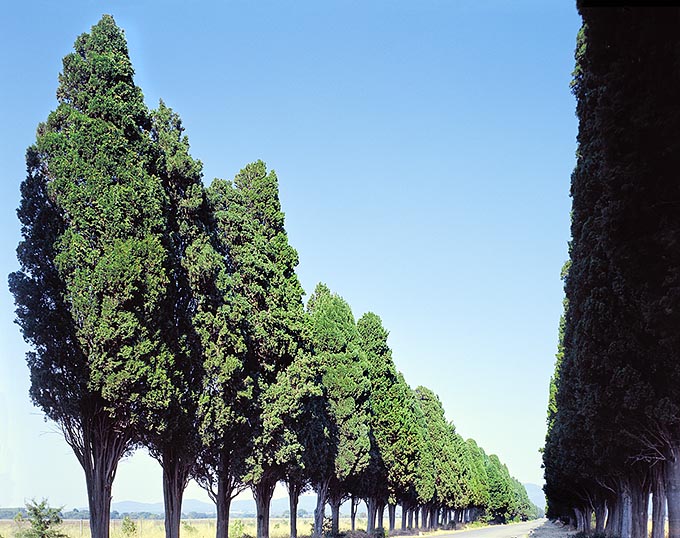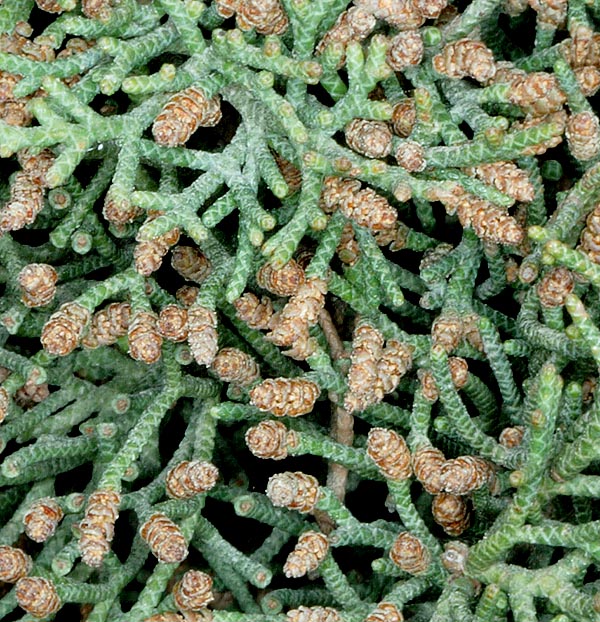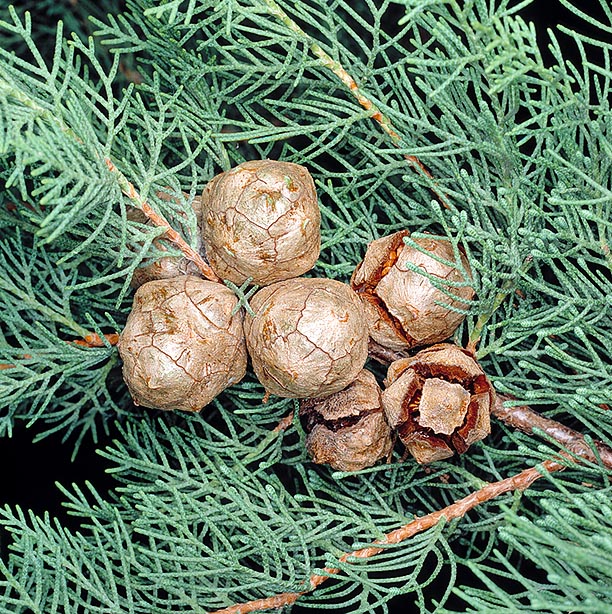Family : Cupressaceae

Text © Eugenio Zanotti

English translation by Mario Beltramini

The famous Bolgheri alley celebrated by the Italian poet and writer Giosuè Carducci. It’s the Cupressus sempervirens var. pyramidalis, now endangered by a serious fungal disease caused by Seiridium (Coryneum) cardinale © Giuseppe Mazza
The genus Cupressus, whose taxonomy has been reviewed eight times during the last 80 years, includes to date twenty five species of evergreen plants diffused in the Mediterranean area, in the Sahara, in northern-western America, in central China. Cupréssus is the Latin name of the Mediterranean cypress (Cupressus sempervirens L. 1753) that comes from the Greek “Kypárissos”, in its turn of Acadian origin (Mesopotamia, III century BC): “kapárru-isu”: “solid tree”, that is, robust tree.
After Ovid (43 BC – 17 AC), Cyparissus was a nephew of Hercules, favourite of the god Apollo, to whom he asked to die because during a hunt had accidentally killed a stag. Apollo, moved to pity, transformed him in a tree born from the tears of the young man and from the blood of the animal.
Other authors associate the name of the genus to Kypros, Cyprus, due to the abundance of the cypresses in that location during the old times.
It is also possible a derivation from the Semitic word “kóper”, meaning resin. The origin of the name of the species sempervirens is intuitive: it comes from the Latin and stands for evergreen.
It is a tree native to Cyrenaica, Aegean Islands, Turkey and Iran, with, therefore East-Mediterranean (Euri-) distribution, but thanks to its beauty, its elegance and the quality of the wood, and consequently its cultivation as ornament and for reforestation, has widely spread since the oldest times in all the circum-Mediterranean countries, especially in Italy: especially in Tuscany and the Peninsula, in Liguria, around the largest lakes, Sicily, Sardinia, Corsica and lesser islands, from the plain up to 700-800 m of altitude, bestowing, along with the olive trees and the oleasters, great beauty to the landscape.
The distinguished professor Valerio Gacomini did write on the subject: “…wherever takes place this harmonious cultural association of the olive tree with the cypress – in the old villas of the Roman hills, on the Umbria hills, or around the Garda Lake – renews one of the most harmonious combinations of shapes and colours the man has ever been able to realize in our urbanized Mediterranean landscape”.

Young cypress branch with male and female growing cones. It’s a long-lived species, with medicinal virtues that may pass the 2000 years and the 35 m of height. The perfumed wood resists to water and wood-worms © Mazza
The cypress is an evergreen conifer with dark foliage and very thick crown, tall up to 20 m tall as an average (but may reach the 35 m and more), slow growing and very long-lived (>2000 years), with straight trunk having grey-ash, fibrous and longitudinally fissured bark; the form is usually columnar and is very branchy since the bottom.
Robust rooting system, with many taproots elongating vertically and horizontally (n the very compact sols).
Cylindrical branches and small ones, not forming buds, covered by tiny squamiform opaque, flattened, obtuse at the apex, leaves, of 1 mm, more or less thickly imbricated.
Isolated male cones, terminal, formed by fertile scales (microsporophylls), yellow, abundantly polliniferous (pollen of pale salmon colour), of 3-5 x 2 mm; the female ones are ovate-globose strobili, lignificant of 2-3 (4) x 2-(2,5) cm, formed by 8-14 fertile scales (macrosporophylls), leathery, irregularly polyhedral, obtusely mucronate, wrinkly, shaped like a shield and supported at the centre by peduncles (peltate).
At first, the scales of the galbuli fit together closely thus protecting the forming seeds, then, when ripe, they detach from each other allowing the seeds to fall down. The cones (strobili or galbuli) are glossy and green when unripe, then, when ripe, they become grey-yellowish or grey-leaden; they produce in the autumn after the fecundation 8 to 20 small seeds (4 x 3 x 1 mm) for scale, reddish, flattened-tetragon, with a narrow crest acting as wing, which disperse in January-March of the following year. The reproductive period takes place from February to May and the pollination is entrusted to the wind.
The cypress is a thermophilous, xerophilous species, as an average heliophilous, indifferent to the substratum and very frugal. The best zones for its cultivation are the Mediterranean ones of the Holm oak woods (Quercus ilex) and the sub-Mediterranean of the woods of Downy oak (Quercus pubescens) and other thermophilous deciduous trees.

The male cones (microsporophylls) produce abundant pale salmon pollen © Giuseppe Mazza
It is present under two forms:
the var. fastigiata (or pyramidalis), known as “male cypress” (improperly, being a monoecious species), often polycormic, with erect branches, close to the trunk and dense crown, columnar and tapered, the most sought for road and perimeter borders besides for windbreak bands good for protecting the precious cultivations of citrus trees, other fruits and the orchards cultivations.
the var. horizontalis or “female cypress”, probably ancestral, monocormic, with spread branches and series of branches forming an ampler crown; is considered as the natural form and that, thanks to the unique, less gnarly, trunk and a faster growth, is the one having a major silvicultural interest.
In Tunisia is present also the Numidian variety (by some authors considered as a geographic form), known as Numidian cypress. The trunks of some cypresses of the Mediterranean area have passed the 6 metres of circumference and the respectable age of 800 years.
The wood of cypress, of which in the past was exalted especially the duration, the scent, the valuable fibre, has yellow-brown alburnum and little darker duramen, with pinkish or reddish hues; is compact, has no resiniferous ducts, is fine-grained, hard and unfading even if in water; is much appreciated for the construction of furniture, doors and frames, valuable marine compasses; in particular, it is sought for making chests and cabinets because it can be very well honed and especially due to its aromatic perfume which keeps away the moths and is not attacked by the woodworms. It is also appreciated by the sculptors, who, especially yore, were making with it statues dedicated to the various divinities and, particularly in the residences of the oriental nobles, the carpenters used it for doing ceilings. The Athenian Thucydides (460 BC ca. – after 404 AC) refers that the warriors dead for the motherland were entitled to have coffins of cypress; also the old Egyptians imported the trunks of cypress for building cases where to conserve their mummies; many old civilizations employed it widely in the shipbuilding. Since the remote antiquity this austere tree was the classical ornament of the graveyards; it was said that, once cut, it could not grow again any more thus becoming the symbol of the death, but, also, its evergreen crown and the incorruptible wood did symbolize the eternity of the soul. All Latin authors recall insistently this tradition, as is the case of Lucanus, Ovid, and Virgil. The decoction of wood of cypress is an excellent footbath against the feet stinking perspiration.
A serious fungal disease caused by the fungus Seiridium (Coryneum) cardinale (Deuteromicete) is decimating the cypresses (cypress canker); the struggle is quite hard. Also in Italy they are working on some stirps in order to get clones (Bòlgheri and Florentia for the var. pyramidalis and Agrimed and Etruria for the var. horizontalis) that have a major resistance to the cryptogam, thing that has been found also in a relict species, the Cupressus dupreziana, of which they have discovered few tens of old specimens on the southern mountains of the Algerian Sahara, is quite similar to the common cypress from which distinguishes due to the distichous disposition of the small branches (in a unique level) instead of in all directions.

The female cones (macrosporophylls) open when ripe releasing the seeds © Giuseppe Mazza
Usually, the cypress propagates by seed, excepting the employment of the grafting for the multiplication of varieties of particular value such as the ‘Cereiformis’, ‘Contorta’, ‘Fortuselli’, ‘Mostruosa’, ‘Pendula’, ‘Variegata’, ecc.
In Europe have been introduced some other species of the genus Cupressus, like Cupressus macrocarpa (Monterey cypress) very sensitive to the cypress canker, native to North America, Cupressus lusitanica (Mexican white cedar) since long naturalized in Portugal but native to Mexico and Guatemala, Cupressus arizonica (Arizona cypress) of southern USA and northern Mexico, the most diffused in Europe. Cupressus sempervirens has, in turn, naturalized in America, diffused in northern India and in China.
The properties of the balsamic oil extracted from the unripe galbuli and from the leaves (Cupressi aetheroleum or Oleum cipressi) were already known to the Assyrian-Babylonian civilization, as witnessed by the inscriptions found of those populations. The yield varies from the 0,2 to the 0,6%; it contains a twenty constituents among which mainly alpha-pinene, carene, sabinene, camphene, myrcene, cedrol, limonene, sylvestrol, terpinolene, cymol, cadinene, phurphurol, valeric acid, in addition to one camphor; moreover, in the galbuli are present cathetic tannins, mucilaginous and pectic substances. This acts modifying the vein circulation as angiotonic and decongestant modifying the tone of the capillaries, increasing consequently the “vis a tergo” (gradient of pressure residual arteriole-capillary) and preventing the venous stasis.
Thanks to the camphorated-resinous cool and balsamic scent, the essential oil of the cypress is much used also in the perfume industry and in the deodorants. In phytotherapy they get from it extracts employed as astringent and vasoconstrictor in the cases of menopause metrorrhagia or, locally, for internal use (tincture and fluid extract) and external (soft extract), in the treatment of the haemorrhoids and of the varicose veins. The essential oil is indicated for inhalations (fomentations) against the whooping cough. Furthermore, the galbuli have tonic properties for the bladder, antidiarrheic, antihemorrhagic, antiseptic and antispasmodic (whooping cough), and are also active against the benign prostate hypertrophy and in the urinary incontinence.
Synonyms: Cupressus foemina Garsault (1764); Cupressus mas Garsault (1764); Cupressus horizontalis Mill. (1768); Cupressus sempervirens var. stricta Aiton (1789); Cupressus lugubris Salisb. (1796); Cupressus patula Pers. (1807); Cupressus pyramidalis O.Targ.Tozz. (1810); Cupressus fastigiata DC. (1815); Cupressus conoidea Spadoni (1826); Cupressus sempervirens var. horizontalis (Mill.) Loudon (1830); Cupressus expansa Targ.Tozz. ex Steud. (1840); Cupressus horizontalis var. pendula Endl. (1847); Cupressus roylei Carrière (1855); Cupressus tounefortii Audib. ex Carrière (1855); Juniperus whitleyana Miq. (1857); Cupressus stricta Mill. ex Gordon (1858); Cupressus thujifolia Knight ex Gordon (1858); Cupressus globulifera Parl. (1860); Cupressus sphaerocarpa Parl. (1860); Cupressus umbilicata Parl. (1860); Cupressus thujiformis Parker ex Gordon (1862); Cupressus thujioides H.Low ex Gordon (1862); Cupressus sempervirens var. globulifera Parl. (1868); Cupressus sempervirens var. sphaerocarps (Parl.) Parl. (1868); Cupressus sempervirens var. umbilicata (Parl.) Parl. (1868); Chamaecyparis thujiformis R.Sm. ex Gordon (1875); Cupressus sempervirens var. pyramidalis (O.Targ.Tozz.) Nyman (1882); Cupressus orientalis Beissn. (1891); Cupressus sempervirens fo. horizontalis (Mill.) Voss (1895); Cupressus horizontalis (Mill.) Voss (1907); Cupressus sempervirens fo. numidica Trab. (1913); Cupressus sempervirens subsp. horizontalis (Mill.) A.Camus (1914); Cupressus sempervirens var. pendula (Endl.) A.Camus (1914); Cupressus mariae Sennen (1928); Cupressus sempervirens fo. stricta (Aiton) Rehder (1949); Cupressus sempervirens var. atlantica (Gaussen) Silba (1981); Cupressus sempervirens var. dupreziana (A.Camus) Silba (1981).
→ To appreciate the biodiversity within the CUPRESSACEAE family please click here.
